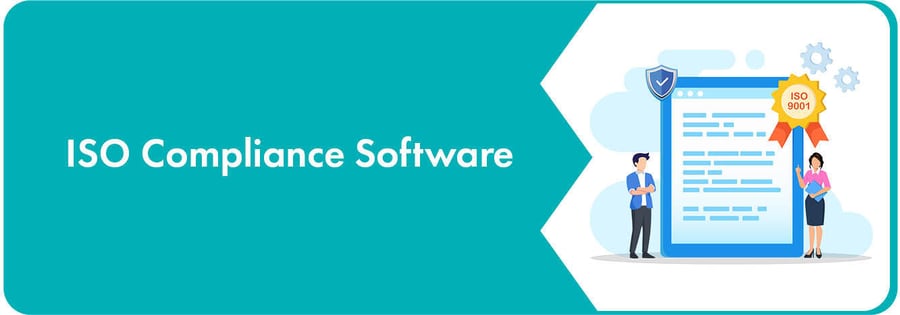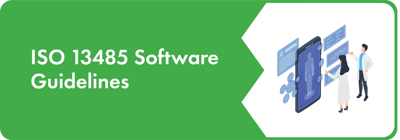
From Complex to Clear: The Case for ISO Compliance Software
September 10, 2024
Quality is a subjective word that means different things to different people. But in the business world, undefined quality can lead to misunderstandings and bad investments, potentially causing untold negative consequences. Helping businesses and other organizations define best practices and manage quality is the goal of standards developed by the International Organization for Standardization (ISO), a non-governmental organization that brings together experts from around the world to develop best practices that help identify and ensure consistent quality and safety in products and services.
The most widely used of these is ISO 9001, a globally recognized standard for quality management. Compliance with ISO 9001 and other ISO standards, while not mandatory, is often a condition of legal compliance with governing bodies, such as the U.S. Food and Drug Administration (FDA). What’s more, many businesses will only use products from other companies that can demonstrate compliance with relative ISO standards.
Unfortunately, compliance with ISO standards can seem unnecessarily overwhelming since processes generally involve activities that do not directly contribute to output. Luckily today’s ISO compliance efforts can be greatly simplified for companies who implement ISO compliance software, like QT9’s quality management system (QMS). This article explains how ISO compliance software helps businesses manage compliance tasks and what features to look for when considering implementing an ISO compliance software solution.
Defining ISO compliance
ISO compliance varies depending on industry, but in general it refers to effectively meeting standards set out by ISO in conjunction with global experts whose mission is to distill their experience and knowledge into agreed-upon best practices. ISO standards help businesses, consumers and governments ensure that products and services are safe, reliable and of high quality. A smaller number of ISO standards focus on environmental sustainability and ethical practices.
Along with ISO 9001, some of the most widely used ISO standards include:
-
ISO 45001, occupational health and safety
-
ISO 27001, information security
-
ISO/IEC 42001, information technology
-
ISO 14001, environmental management systems
-
ISO 13485, medical device quality and safety
What is ISO compliance software?
ISO compliance software simplifies an organization’s ability to meet ISO requirements by providing automations and integrations that eliminate time-consuming, error-prone manual compliance tasks. For instance, document management capabilities in ISO compliance software allow documentation to be electronically routed for review and approval, automatically archiving outdated document versions and helping ensure the entire organization is using the most up-to-date policy or procedure. ISO compliance software makes it easy to capture documentation, data, signatures, and all the other things that demonstrate compliance, and easily shares this information with auditors and customers.
In addition to compliance task automations, ISO compliance software streamlines and centralizes data and processes, so that departments and offices can more easily collaborate, no matter their location. Built-in conveniences, such as reminders and alerts, also help users keep track of tasks and due dates.
Quality and ISO compliance software
Even though not specifically stated, it can be said that quality is an integral part of almost every ISO standard. This is especially true since so many ISO guidelines build off the grandaddy of quality standards: ISO 9001. ISO 9001 specifies requirements for the establishment, maintenance and continuous improvement of a quality management system, emphasizing customer satisfaction, quality control, productivity and continuous improvement. Achieving ISO 9001 compliance or being certified to the standard shows current and potential customers that your business has created processes and trained employees to produce quality products or services.
Many industry-specific ISO standards build off of ISO 9001 to create quality standards that best address their needs. These include:
-
ISO 13485 for medical devices
-
ISO 29001 for petroleum and natural gas-related products
-
ISO 17025 for testing and calibration labs
Several industry oversight organizations, such as the International Automotive Task Force (IATF) and the International Aerospace Quality Group, base their industry standards off of ISO 9001, including:
-
AS9100, an internationally accepted quality system standard for the aviation, space and defense industries
-
IATF 16949, an international standard for quality management systems in the automotive industry
Key features of ISO compliance software
ISO compliance software helps organizations navigate the steps to attaining ISO compliance, no matter the standard. It provides a way for companies to centrally track compliance processes, automate tasks and provide real-time data that can assist in making relevant business decisions. Key features of ISO compliance software include:
-
Document control: The ability to create, manage versions, route for approval and control access to important documentation, including policies, procedures, work instructions and records. Document control enables easy accessibility, trackability and traceability.
-
Risk management: Risk management applications help a business identify, assess and manage risks to production or company objectives.
-
Nonconformance management: These applications track and manage nonconformities, incidents and deviations from established processes, and facilitate the investigation and implementation of corrective and preventive actions.
-
Employee training: Employee training applications help identify training gaps, create training, track employee training progress, and alert employees and management to training status to ensure ISO compliance requirements are being met.
-
Change control: Any changes to processes often need to be documented and controlled to prevent adverse impacts on quality. Change control applications ensure that changes are assessed, approved and communicated effectively.
-
Supplier management: Supplier management modules automate communication and control supplier-related documentation, evaluate supplier performance and ensure that purchased products and services meet quality standards.
-
Customer interaction: Applications can capture, analyze and manage customer feedback to measure and improve customer satisfaction.
-
Automated processes: Built-in automations simplify processes to help ensure you stay on track, including notifications, alerts and reminders. Many applications are integrated, such as document control and employee training, and corrective actions and supplier management.
Benefits of ISO compliance software
The main benefit of using ISO compliance software is getting automated guidance for meeting ISO standards with simplified processes that centralize information and streamline tasks. Other key benefits include:
-
Audit preparedness – Documentation needed for regulatory compliance is automatically generated, tracked and stored through its lifecycle. ISO compliance software has embedded processes for meeting the standards.
-
Real-time monitoring and reporting – ISO compliance software serves as a repository for the most up-to-date data surrounding your operations.
-
Improved efficiency and enhanced customer satisfaction – Better processes lead to efficiencies that allow you to bring your product to market faster while maintaining quality and improving customer satisfaction.
-
Better decision making – With a centralized, automated system, the latest data is always at your fingertips, ensuring decisions are made based on current information.
-
Cost savings – Automating compliance tasks, such as document control, frees employees up from time-consuming administrative tasks, allowing them to focus on more value-added activities.
-
Leadership responsibility – Compliance software gives management an easily accessible, comprehensive view of business activity across the board, allowing them to easily demonstrate involvement and commitment.
-
Continuous improvement – Continuous improvement actions are increasingly called for in ISO and other regulatory compliance standards. ISO compliance software enables users to easily demonstrate their Plan-Do-Check-Act processes.
-
Integration of quality processes – ISO compliance software automatically generates next steps in your quality processes with interconnected applications, so tasks like risk assessments and supplier reviews are automatically generated.
ISO compliance software and QT9 QMS
QT9 QMS software is an award-winning ISO compliance solution that is geared toward quality and regulatory compliance. With more than 25 modules that come standard, QT9 QMS is one of the most effective tools a business can use to ensure alignment with ISO standards. QT9 QMS automates compliance processes, including:
-
Document control
-
Management review
-
Risk management
-
Employee training
-
Change control
-
Corrective actions
-
Supplier management
QT9 QMS offers an easy user interface and is backed by free software updates, full customer support an available ERP integration and Business Intelligence tool.
By automating tasks, centralizing data and integrating quality processes, ISO compliance software can help your business not only meet ISO standards, but also many other standards and regulations. Whether you need document control, risk management or employee training, QT9 QMS ISO compliance software provides a comprehensive solution to manage the complexities of compliance with ease and efficiency.
Additional ISO Compliance Resources
ISO 13485 Software Guidelines
Today's medical device regulatory environment puts the onus for quality mostly on the shoulders of medical device manufacturers...
Read Article
Understanding ISO 9001 Software
ISO 9001 software helps organizations reduce risk, optimize operations and maintain regulatory compliance...
Read Article




